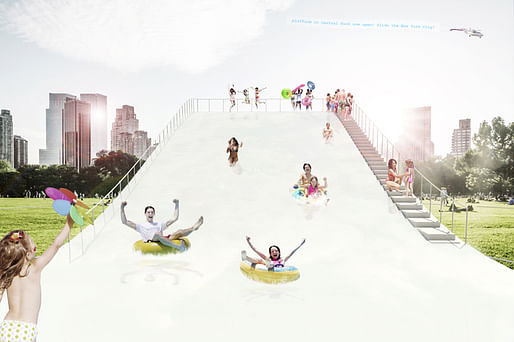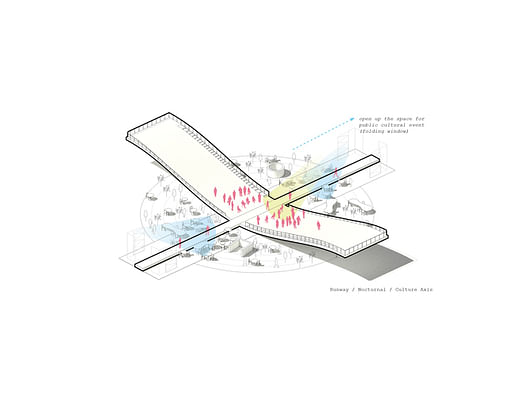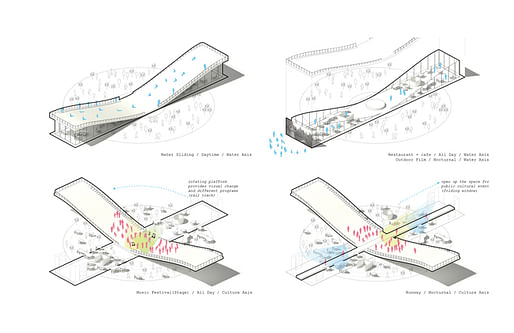
Central Park Summer Pavilion Competition was open for international architects. The CPSP was envisioned as a meeting point for different cultural and leisure circuits, with the goal of using the same space for a broad range of daytime and nocturnal activities in a sustainable fashion that respects its surroundings. The idea was for it to become an obligatory stop for visitors to Central Park.

Chang Kyu Lee New York based architectural designer and Dokyung Kim from University of California, Los Angeles won the second prize on this competition with a project challenges definition of linear gesture. The ‘plaYform’ proposes a “space of experiences” - simply pushed-down a plaTform connects human and nature as a ‘plaYform’ at the same time a simple linear gesture defines a whole proposal that shows as an object.

A gigantic Central Park is the emblematic piece of urban break space in New York City. Central Park is the most visited park in the United States and holds numerous trees and species of animals. The park is a urban scale and a space that separates two urban fabric relationships.

A ‘plaYform’ is a place of great public destination; an exploration and a shelter. A ‘plaYform’ is also a point and a place that meets different leisure and cultural circuits (axis). The ‘plaYform’, therefore, is also a shelter from the world (inward) and a place of center to explore the world (outward). From daily uses to special events, the ‘plaYform’ accommodates various activities. Multipurpose ‘plaYform’ in the Central Park can accommodate events such as water (summer) / snow (winter) sliding, music festival, open air cinema, fashion show runway and restaurant with café. Thus, the project integrates existing communities and nature not only physical but also programmatic manner, and provides new space to rejuvenate the community and the everyday summer life of NYC neighborhoods.

The project ‘plaYform’ proposes a “space of experiences” - simply pushed-down a plaTform connects human and nature as a ‘plaYform’. The project opens up the visual and physical corridors between two urban fabric relationships: water axis (North to South of Central Park) and culture axis(West to East of Central Park). At the same time the ‘plaYform’ creates a smooth program transition from the rotation that provides opportunities for various programs.

The ‘plaYform’ is located between 81st and 82nd st and 6th and 7th ave. When it is positioned in north – south of Central Park, the plaYform represents water axis that connects water way of Central park and when it is positioned in south and west of Central Park, the plaYform represents culture axis that provides cultural programs to residents. Rotating the ‘plaYform’ is a gesture not only provides visual change but also offers different program. The project provides versatile summer public programs which attract visitors, blend diverse culture and neighbors. For example, when it is located in water axis it becomes place for water sliding(daytime), and when it relocated in culture axis it becomes stage, fashion runway (nighttime). The large green open space gives New Yorkers space to interact, play, relax, and gather. The open space is for large gatherings and the wall of this ‘plaYform’ becomes movie screen for open air cinema. plaYform invites people in all ages to experience different programs of curved surface.

Creating a sustainable space from the simple architectural gesture is what we should pursuit, therefore, ‘plaYform’ that integrates human and nature with the culture programs create a great sustainable value.

‘PlayForm’ celebrates human and nature interaction through simple architectural gesture while maintaining as a place of great public destination.
Comments from jury:
"A simple linear gesture defines a whole proposal that shows as an object. Simple but very effective informal terms, of uses and in the landscape integration it could become one of the landmarks of New York City."
"Its clarity, lightness and rationality give the Project a simple but very attractive appearance that suits all the program of uses. A smart way of using the multifunctional spaces that can be transformed depending on the season and the users."
"One object, many uses. One object, many different people who can join it."
1 Comment
This is so dumb. Thanks Bjarke! I guess I should thank Rem too. Thanks Rem!
Block this user
Are you sure you want to block this user and hide all related comments throughout the site?
Archinect
This is your first comment on Archinect. Your comment will be visible once approved.